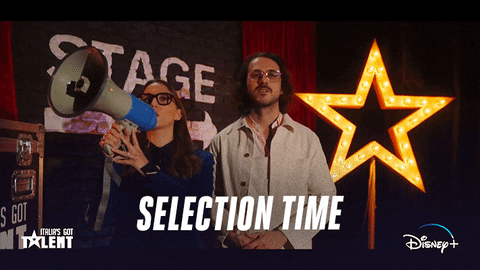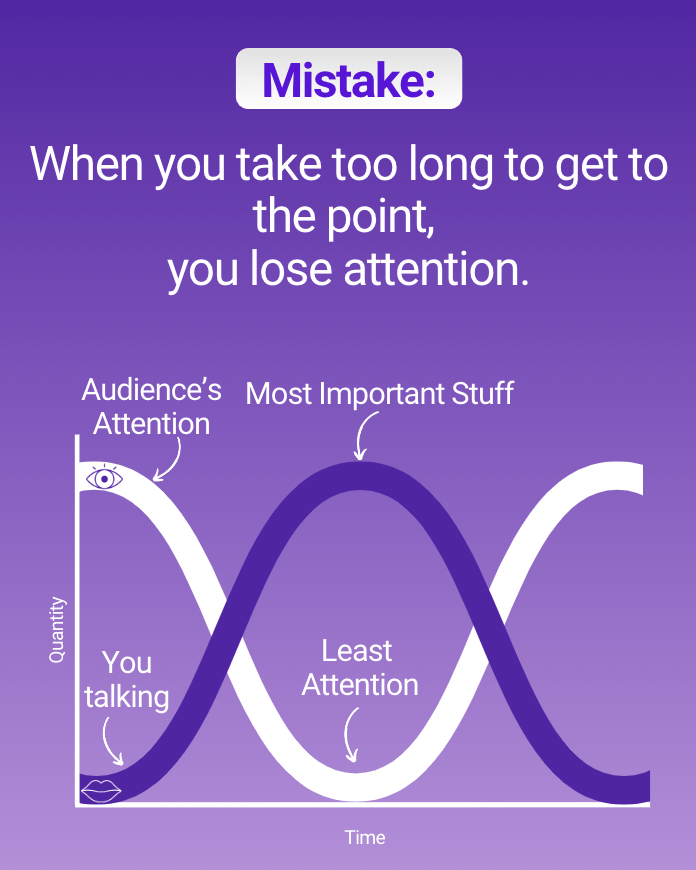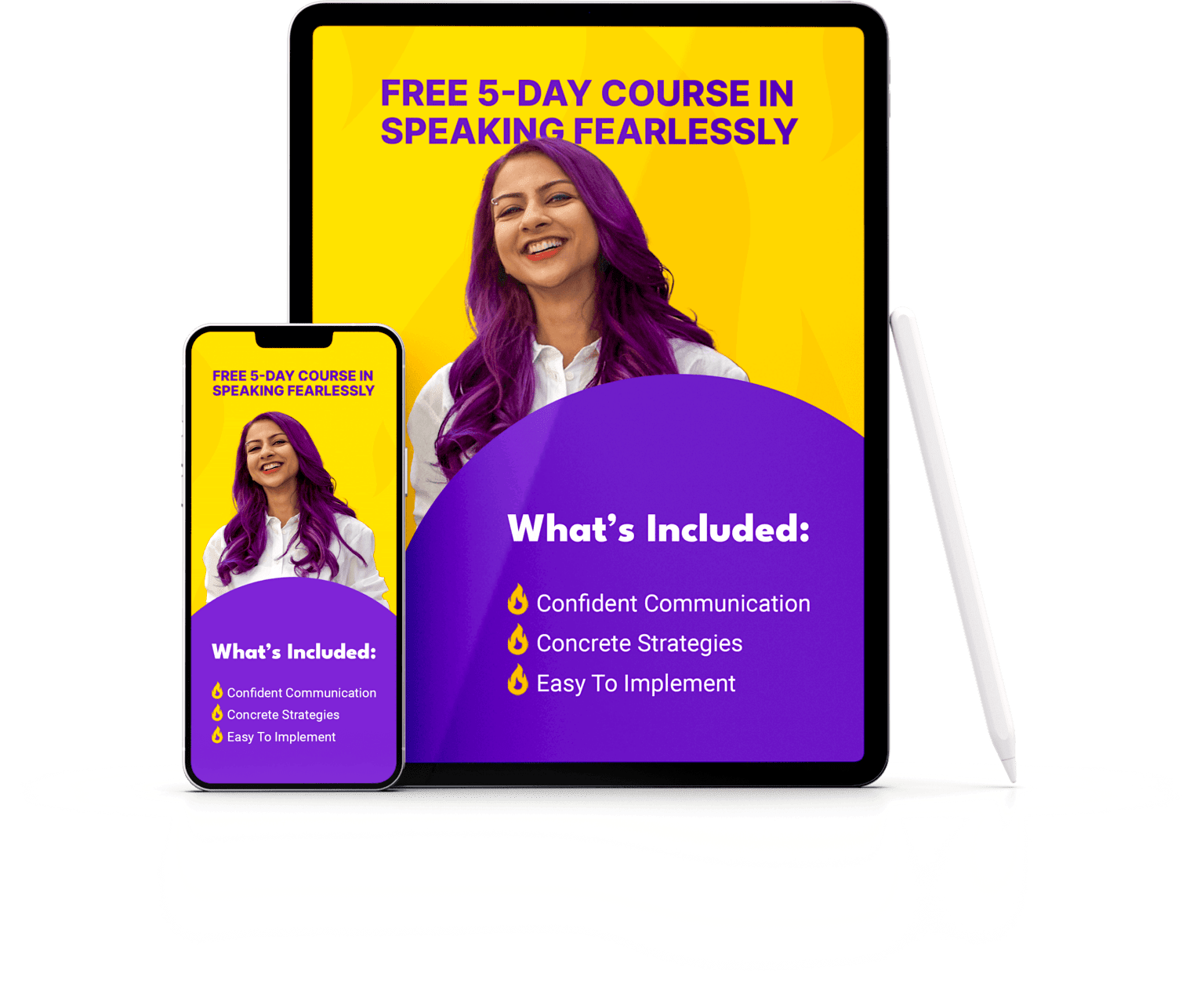Understanding how to deliver a TED or TEDx talk isn’t just about going on stage. It’s about the journey through preparation, rehearsal and mastering the art of impactful storytelling.
Welcome to the world where ideas are worth spreading.
Each year, over 1,000 TED talks surface online, inspiring millions of people worldwide. That’s equivalent to enlightening the entire population of San Francisco, every single day.
| I remember when I got that acceptance call for my first TEDx talk. I felt ecstatic for 2 whole minutes before feeling immediate dread and imposter syndrome. Since then I’ve done 3 TEDx talks and am happy to share everything I learned during the process. |
Learning how to do a TEDx talk is like creating a major shift away from ordinary presentation methods. It’s about becoming a storyteller that leaves an impact with your audience.
In this guide, you’ll learn how to start developing your TEDx idea, pitch it and prepare for your talk.

Table of Contents
Understanding the TED mission and criteria
In this section, you’ll:
– Decode TED’s mission to aid application
– Select the ideal TEDx event for your presentation
– Structure an application that TEDx Talk scouts would crave
Step 1: Understanding the TED Talk Mission
TED, known for spreading influential ideas, functions under a mission to share ideas that are worth spreading. This mission influences TED’s decision-making process when scouting for speakers, significantly affecting the acceptance or rejection of applications.
If you understand TED’s mission, this will give you an upper hand. Providing a talk that aligns with TED’s mission increases your chances of selection.
You’ll most likely be pitching for a TEDx event, not the main TED event (which is super high profile and mostly has celebrity-level speakers). TEDx events bring TED’s mission of “ideas worth spreading” to local communities, organizations, and individuals. These events are independently organized and coordinated on a community-by-community basis, following TED’s guidelines.

Step 2: Understanding the TED Talk Selection Criteria
– Explore why unique content holds the key to passing the TED Talk selection process.
– Learn how relevance to current issues and trends boosts your chances.
– Discover how expressing passion for your subject could multiply your opportunities.
The Secret Behind Originality in TED Talk Selection
But what’s an “idea worth sharing”?
According to official TED guidelines, your TEDx-worthy idea must:
- Be somewhat new or surprising.
- Appeal and be relevant to a wide, diverse audience.
- Must be actionable, and not just purely theoretical.
What makes a good idea for a TEDx talk? Your idea should be new, surprising, or challenge existing beliefs. It needs to draw a larger conclusion from evidence or observations. To know if your idea is ready, write it down and ask if it’s new, interesting, and backed by facts. If not, refine it with feedback from others, including those outside your field and your TEDx event team.

How Relevance Plays a Key Role in TEDx Talk Selection
In a rapidly changing world, ‘now’ is the watchword. TEDx Talk curators seek ideas that address current issues and topics. Not only does a relevant TEDx Talk resonate with current global conversations, but it also drives significant interest and engagement. A strong tie-in with timely discussions can propel an applicant closer to the TEDx stage.
The hottest TED talk topic in 2023 was AI, highlighting its revolutionary advancements and future implications. In 2024, the topics explore more on personal growth for a journey of self-improvement. These talks cover topics like parenting, mental health, confidence-building, and sustainable habits.
Overall, your topic must be relevant to a broad, diverse, layperson audience. Highly technical, specialized and niche topics might have lower relevance for a wider audience and hence a lower success rate in getting selected.
The Power of Expertise
Curators are keen on identifying your “obsession” with the subject matter, as it is a testament to your dedication, depth of knowledge and likely indicative of a more engaging talk. An impassioned speech can create a stirring experience, resonative of TED’s enduring tagline, “Ideas Worth Spreading.”
In your pitch, you must show the TEDx organizers why you’re the best person to deliver the talk you have in mind. You don’t need to be the top expert, but you must be knowledgeable and fact-check your information. I’ll guide you through creating your pitch a bit later in this article.
For a successful TEDx Talk, keep in mind that originality, relevance, and passion work together. These elements combine to create a compelling proposal, boosting your chances of being selected to speak on the TEDx stage.

Photo from Unsplash
Step 3: Finding the Right TEDx Event
TED and TEDx organizations across the world present a diverse range of events, each with unique objectives and themes.
Picking the perfect TEDx event is key to succeeding in getting your pitch accepted. It can also be, of course, monumental to the eventual success of your talk. The right platform can really boost the impact of your ideas and connect you with an audience who’s genuinely interested in what you have to say.
My top 3 tips for finding the right event to pitch for:
- Aim to find events in cities that are mid-tier. TEDx in major cities like TEDx NYC or TEDx London will be saturated with too many applications.
- Find events that will be filmed. You’d be surprised at how some aren’t. Your key to a successful talk is one that will be filmed and put online on the TED YouTube channels and website.
- Target events that are 5-8 months away. Most TEDx organizations find speakers at least 3-5 months ahead of their event schedule.
| How I got my second TEDx talk: sheer luck or clever strategy? When I applied for my second TEDx talk, the event organizer politely rejected my application. I had forgotten about it till one Wednesday, I got a frantic call: “Nausheen, are you still interested in doing your TEDx talk? We had a last-minute cancellation”. Great news, right? The catch: the event was on Saturday. I had 2 days to develop, memorize and deliver my talk. I said yes. There was no other answer. And then I worked like a madwoman writing, refining, putting together, rehearsing and memorizing my talk. I delivered it that Saturday 100% from memory, without any slides, prompts or cue cards. The moral of the story: Don’t ever say no to an opportunity, even if you haven’t figured out how you will accomplish it yet. |
Crafting a successful TEDx Application
– Identify a subject that marries TED’s objective and captivates your spectators.
– Nail your narrative layout for optimum impact.
Embarking on the TED Talk journey involves multiple meticulous steps. However, the process becomes manageable by breaking it down into bite-sized chunks. Keep in mind, your goal is to share a compelling talk that captivates your audience and aligns with TED’s mission.

Step 4: Choosing Your Topic
The spark behind a memorable TEDx Talk is the hypothesis. Does the topic fulfill TED’s mission of spreading ideas that fuel change? If yes, you’re in the right direction. Make sure you’re excited about the subject and that you’re qualified or experienced to talk about it.
Ask yourself 3 questions to brainstorm on the right topic for you:
- What do I want to be known for?
- Do I have a new, surprising hypothesis to share about this subject?
- Can I back up my hypothesis with facts, experience, statistics, quotes?
My first TEDx talk was highly personal. I knew I wanted to “tell my story”. But for my talk to be selected, I needed to make it relatable to a broader audience. So I used the story of my early midlife crisis to outline how there is power in breaking your beliefs – a framework for re-examining and re-constructing your belief system.
I wanted my second talk to be connected to my area of expertise – speaking in public. So I talked about how crafting and telling your story is an act of rebellion and empowerment.
And for my third talk, I wanted to explore the idea of confidence – so I responded to the question: “What came first – confidence or action?”
Step 5: Your TEDx Application
A successful application comes down to a well-crafted presentation of your ideas. TED scouts are on the hunt for innovative, thought-provoking, and powerful ideas that can cause a domino effect of positive change.
Conciseness, clarity, and passion are key ingredients in your application. Represent your ideas crisply and clearly.
I’d advise against using AI to write your application. Aim to write it simply, in your own words. Your goal should be to prove that your talk can have a wider impact on a diverse audience. Add facts, anecdotes, or insights you plan to share.
If your idea deserves to be heard, make sure it’s captured in your application. In the speaker nomination form, you will be asked to write:
- A brief biography that connects you to their topic.
- The unique idea that you want to share.
- Key takeaway of what you want the audience to grasp or feel after your talk.
Pro-tip: You don’t need to have your entire talk ready before you pitch it!
How to apply for a TEDx event Here is a 5 step guide to actually find the event you want to apply to, and make the application: 1. Search for relevant events in the areas and dates you’re interested in (see my guidance in step 2 on how to find the right event). You can use the TED website to find these TEDx events: https://www.ted.com/tedx/events. 2. Search for the event’s own website. Most TEDx events have their own website with an application form. 3. If you can’t find the website or the application form, look up the event organizers on LinkedIn, Twitter or Instagram. 4. Send them a polite message just asking for the application form or more details about the process. It’s crucial that you don’t approach them with a salesy, aggressive pitch, or you might become a nuisance for them. 5. Send in the application form by email or submit it through the TEDx event’s website. Each TEDx organizing committee has their own process – so it’s worth figuring out what the exact process is for the event you want to apply for. In general, you may need to apply to 20-50+ events to get accepted. If you don’t get accepted, do ask the TEDx organizers how you can improve your application in the future. |
Preparing for a TED Talk: What to Expect After Being Accepted
– Understand the preparation timeline before your big day
– Discover the resources and support provided by TED
– Familiarize yourself with the flow of the day of the TED Talk
Step 6: How to ace the TEDx interview process
Once you get the first email of interest in your topic, you might have several interviews ahead of you.
First of all, congrats! A majority of applications don’t make it past the initial screening. Just the fact that you’re proceeding on to stage 2 of the application process is a sign that your idea has TEDx potential.
Get ready for an initial informal interview with the key organizer, and a second or third interview with a group. You will be expected to:
- Introduce yourself and the idea you want to talk about.
- Give a brief overview of what you’d like to talk about – going into the key takeaways, framework etc.
- Discuss and justify why your idea is one that’s worth sharing on the TEDx stage.
At this stage, it might serve you well to write a bullet point outline of your talk, just so you can show the organizers the amount of thought, research and passion you’re ready to bring.

Step 7: The Preparation Timeline
After receiving the much-awaited acceptance from TEDx, many speakers are left wondering about the journey ahead. Establishing a clear timeline from now till the day of your talk is very important.
According to the TEDx Speaker Guide, you have a 5-step process ahead of you – taking you from behind your computer to the red dot on the TEDx stage:
Step 1: Get familiar with the format: TEDx speakers present their ideas in under 18 minutes. Audiences can focus well on one topic for short periods and that makes their talks work.
Step 2: Craft and develop your talk, in discussion with your TEDx organizers. At this stage, they may assign you a mentor who has gone through the process before.
Step 3: Rehearse – by yourself and in front of an audience. Your TEDx event may also organize official rehearsals.
Step 4: Deliver your talk!
Step 5: Breathe the biggest sigh of relief – the stressful bit is all done and now you get to look back at your first TEDx talk!

Developing your TEDx talk
Step 8: Structuring Your Talk
It’s time to make an outline and script based on your pitch. There are various theories on presentation structure. Here’s a structure that works well in general:
- Start by making your audience care with a relatable example, story, question or intriguing idea.
- Explain your idea clearly and convincingly.
- Provide evidence and explain how your idea could be put into action.
- End by discussing how your idea could impact your audience if they accept it.
Whatever structure you choose, focus on effectively communicating your idea, rather than storytelling or eliciting emotions—they’re tools, not the main goal. Your structure should be seamless to the audience; avoid discussing how you’ll present your topic—just dive into it.
How I structured my TEDx talk on “What came first: Action or confidence? Here is the exact outline I used for my third TEDx talk: 1. I started with a story: my client Susan wanted to be confident before she spoke on stage, but discovered confidence afterwards as a result of the speaking, not a prerequisite. 2. I use the story as a jumping off point to ask the question: “But does that mean you automatically gain confidence once you do a scary thing?” 3. I then share research done by a behavioral scientist on how confident people respond to hardships and success, compared with those with reported low self-esteem. I shared findings on how confident people choose to use positive outcomes to boost their confidence, while those with low confidence don’t let positive outcomes change the way they think of themselves. 4. I explored how the audience can benefit from this insight: they can choose to shape their interpretation of their experiences to be confidence-boosting or confidence-dampening. 5. I end with an analogy – confidence isn’t like a trophy you keep on a shelf. It’s like an armor that you construct and wear to weather any storm. |
Step 9: Rehearsing Your Talk
Practice sessions transform plans into outstanding presentations. Try different elements like intonation, pacing, body language, and facial expressions. Remember, you’re not there to recite pages but to share a story.
Get comfortable with your material, practice with friends, family, colleagues, and do dry runs. Accept feedback and continue rehearsing to sound natural.
Record yourself and find out how you can improve. It’ll help you discover where you typically trip up or find yourself searching for words.
Every minute of this wonderful journey of crafting your TED Talk – right from selecting your topic, structuring your talk, to rehearsing it – is a step towards sharing a memorable story.. Remember, the main objective is not to deliver a stellar performance, but to share a compelling story and idea with the world.
Mastering TED Talk Presentation Skills
– Developing an engaging technique to pique the audience’s interest from the get-go.
– Smart, effective use of visual aids for enriching the presentation.
– Overcoming stage fright to deliver a confident presentation.

Step 10: Engaging Your Audience
You’re more likely to capture the audience’s attention within the first 20 seconds. Great storytellers do this by creating compelling introductions that grab the audience’s attention right away.
Initial Interest Spike
The key is to first create an initial interest spike. No one latches onto monotonous facts, but everyone loves a good story. Deliver an anecdote, share fascinating numbers, or reveal a quirky piece of trivia about your topic. This not just intrigues your audience but also sets the tone for your presentation.

Here’s how you can create a captivating introduction according to the TED manual.
- Draw in your audience with something they care about.
– If it’s a topic the general TED audience thinks about a lot, start with a clear statement of what the idea is.
– If it’s a field they never think about, start off by talking about something they do think about a lot and relate that concept to your idea.
– If the idea is something fun, but not something the audience would ever think about, open with a surprising and cool fact or declaration of relevance.
– If it’s a heavy topic, find an understated and honest way to get off the ground; don’t force people to feel emotional. - Get your idea out as quickly as possible.
By articulating your main idea early on, you set the tone for your presentation and provide clarity to your audience about what they can expect to learn or experience.
- Don’t focus too much on yourself.
When speaking on stage, avoid focusing too much on yourself. Instead, prioritize connecting with your audience and delivering value to them.
- Don’t open with a string of stats
Avoid opening your talk with a string of statistics. Instead, start with a captivating story or compelling question to engage your audience right from the beginning.
One of the 10 most popular TEDx talks is Simon Sinek’s ‘How great leaders inspire action’. He started with a question. In the first 33 seconds of his talk, he asked:
“How do you explain when things don’t go as we assume? Or better, how do you explain when others are able to achieve things that seem to defy all of the assumptions? For example: Why is Apple so innovative? Year after year, after year, they’re more innovative than all their competition. And yet, they’re just a computer company. They’re just like everyone else. They have the same access to the same talent, the same agencies, the same consultants, the same media. Then why is it that they seem to have something different?”
Simon Sinek’s TEDx talk introduction is effective because it immediately captures the audience’s attention by posing a thought-provoking question and presenting a unique perspective.

Maintaining Interest Throughout the Talk
Once you’ve engaged them, your next challenge is to keep them hooked. Break down your content, making sure that each segment follows from the last but also has its own mini “hook”. Use variations in your tone, pace, and volume to highlight important points. Reiterate or summarize key aspects regularly to help your audience keep track.
Step 11: Using Visual Aids Effectively
Slides can be beneficial for the audience, but they’re not always necessary. Consider if they’ll clarify or confuse. Keep slides simple and ensure that they follow your TEDx organizer’s tech specifications and use fonts and images you have rights to. Avoid using images you don’t own or lack permission to use.
Not all visuals enhance a talk. Choosing the wrong type or overloading a slide with information can do more harm than good.

Choosing Relevant Visuals
Your visuals must add value to your talk. They should either clarify a complex point, demonstrate a process or idea, or visually present data that is hard to explain verbally. Use a mix of diagrams, graphs, images, and videos.
According to Dr. Lynell Burmark, visuals are the simplest and the most effective way to make sure that the information gets stored as a long-term memory. Studies show that audio-only information has a retention rate of 10% after 72 hours. Visuals alone have a retention rate of 35%. But, combining the two yields a retention rate of 65% after the same period of time.
Minimizing Distraction
While using visuals, it’s important to avoid overwhelming the audience with too much information at once. Use minimal text, relevant images, and simple charts or graphs. Also, timing your visuals well with your narrative can maximize their impact.
Step 12: Handling Nerves and Stage Fright
It’s natural to feel nervous about delivering a TED Talk, but it’s important not to let it affect your performance.
Managing Nerves
The first step to managing your nerves is to accept them. It’s typical to feel your heart racing or your hands trembling. However, take slow, deep breaths to calm and center yourself. Practice your talk multiple times before you deliver it. This can make you familiar with your content, reducing your anxiety.

Overcoming Stage Fright
To overcome stage fright, set small achievable goals. Initially, try speaking in front of family members or friends. Visualize yourself successfully delivering your talk. This boosts your confidence and reduces stress. This way, when you finally step onto that TED stage, you’ll be less fazed by the crowd’s presence.
The Support from TED
TEDx organizers don’t just drop you onto the red dot and hope for the best. You’re provided comprehensive coaching and technical support to ensure your message is delivered in the most impactful way possible.
TEDx usually offers two main types of support: content coaching and presentation coaching. Content coaching involves refining the content of your talk, ensuring your ideas are clearly articulated. Presentation coaching focuses on how you deliver your message, from your body language to your speech clarity.
TEDx doesn’t pay speakers, and you might need to also cover your own travel expenses. But this is a career-upgrading opportunity and you’ll be making a wise investment into upgrading your authority and credibility.
The Day of the Talk
My first time on the TEDx stage Here is the sequence of events that happened from the time I traveled to the city where I was going to be speaking, to delivering the TEDx talk itself. 1. As soon as I arrived in the city I was meant to speak in, I went to meet the TEDx organizers at the venue. 2. They had reserved a rehearsal space for us, where each of us delivered our talks one by one and got feedback from the organizers and other speakers. 3. The day of the TEDx talk, I arrived super early and got my hair and makeup done (not covered by the event!) 4. I went for a last dress rehearsal on stage. I also took the time to strike up a conversation with the host and re-confirmed the order in which the speakers would go up- I was third. 5. 20 minutes before the event was scheduled to start, I did a final hair, dress and makeup check in the bathroom. This is when I’d also advise running through a quick warmup routine. 6. I sat in the front row as my name was called out. The only thing I regret here was not standing up and adjusting my shirt right before going on stage. I’d recommend standing on the side and being ready vs jumping out of your chair when your name is called out. |
A TEDx day starts much earlier than the audience’s arrival, as backstage activities begin. From last-minute technical checks to final rehearsal and makeup sessions, your day is meticulously planned to ensure a seamless experience.
Once on stage, calm prevails, as a carefully coordinated presentation sequence allows you to focus solely on delivering your message. As your talk ends and the applause quiets down, you can feel proud of sharing your ideas with the world.

Nausheen Chen on TEDx stage
Remember, while the preparation process may seem daunting, the TEDx platform offers a powerful opportunity to share your ideas on a global scale. Imagine delivering your own story on a global stage and empowering others with your unique insights.
Time to Act on Your Stage Fright
Behind the impressive TEDx Talks are speakers who were once terrified of being on that stage. How did they get there? Through working with coaches who helped them refine their topic, develop their talk and deliver it with confidence.
Start making your TEDx dreams come true. Let’s work together.

